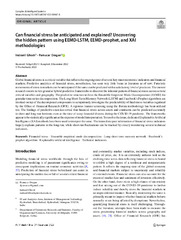Please use this identifier to cite or link to this item:
https://rfos.fon.bg.ac.rs/handle/123456789/2390Full metadata record
| DC Field | Value | Language |
|---|---|---|
| dc.creator | Ghosh, Indranil | |
| dc.creator | Pamučar, Dragan | |
| dc.date.accessioned | 2023-05-12T11:44:57Z | - |
| dc.date.available | 2023-05-12T11:44:57Z | - |
| dc.date.issued | 2022 | |
| dc.identifier.issn | 2199-4536 | |
| dc.identifier.uri | https://rfos.fon.bg.ac.rs/handle/123456789/2390 | - |
| dc.description.abstract | Global financial stress is a critical variable that reflects the ongoing state of several key macroeconomic indicators and financial markets. Predictive analytics of financial stress, nevertheless, has seen very little focus in literature as of now. Futuristic movements of stress in markets can be anticipated if the same can be predicted with a satisfactory level of precision. The current research resorts to two granular hybrid predictive frameworks to discover the inherent pattern of financial stress across several critical variables and geography. The predictive structure utilizes the Ensemble Empirical Mode Decomposition (EEMD) for granular time series decomposition. The Long Short-Term Memory Network (LSTM) and Facebook's Prophet algorithms are invoked on top of the decomposed components to scrupulously investigate the predictability of final stress variables regulated by the Office of Financial Research (OFR). A rigorous feature screening using the Boruta methodology has been utilized too. The findings of predictive exercises reveal that financial stress across assets and continents can be predicted accurately in short and long-run horizons even at the time of steep financial distress during the COVID-19 pandemic. The frameworks appear to be statistically significant at the expense of model interpretation. To resolve the issue, dedicated Explainable Artificial Intelligence (XAI) methods have been used to interpret the same. The immediate past information of financial stress indicators largely explains patterns in the long run, while short-run fluctuations can be tracked by closely monitoring several technical indicators. | en |
| dc.publisher | Springer Heidelberg, Heidelberg | |
| dc.rights | openAccess | |
| dc.rights.uri | https://creativecommons.org/licenses/by/4.0/ | |
| dc.source | Complex & Intelligent Systems | |
| dc.subject | Technical indicators | en |
| dc.subject | Long short-term memory network | en |
| dc.subject | Financial stress | en |
| dc.subject | Facebook's prophet algorithm | en |
| dc.subject | Explainable artificial intelligence | en |
| dc.subject | Ensemble empirical mode decomposition | en |
| dc.title | Can financial stress be anticipated and explained? Uncovering the hidden pattern using EEMD-LSTM, EEMD-prophet, and XAI methodologies | en |
| dc.type | article | |
| dc.rights.license | BY | |
| dc.citation.rank | M21~ | |
| dc.identifier.doi | 10.1007/s40747-022-00947-8 | |
| dc.identifier.fulltext | http://prototype2.rcub.bg.ac.rs/bitstream/id/889/2386.pdf | |
| dc.identifier.pmid | 36589898 | |
| dc.identifier.rcub | conv_2819 | |
| dc.identifier.scopus | 2-s2.0-85144879050 | |
| dc.identifier.wos | 000904046900001 | |
| dc.type.version | publishedVersion | |
| item.cerifentitytype | Publications | - |
| item.fulltext | With Fulltext | - |
| item.grantfulltext | open | - |
| item.openairetype | article | - |
| item.openairecristype | http://purl.org/coar/resource_type/c_18cf | - |
| Appears in Collections: | Radovi istraživača / Researchers’ publications | |
This item is licensed under a Creative Commons License


